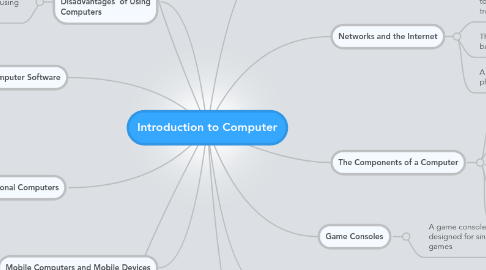
1. Advantages and Disadvantages of Using Computers
1.1. Green computing involves reducing the electricity consumed and environmental waste generated when using a computer
2. Computer Software
2.1. Software, also called a program, tells the computer what tasks to perform and how to perform them
2.2. Installing is the process of setting up software to work with the computer, printer, and other hardware
2.3. A programmer develops software or writes the instructions that direct the computer to process data into information
3. Personal Computers
3.1. A personal computer can perform all of its input, processing, output, and storage activities by itself
3.2. Two popular architectures are the PC and the Apple
4. Mobile Computers and Mobile Devices
4.1. Mobile Computer
4.1.1. Personal computer you can carry from place to place
4.1.2. Examples include notebook computers, laptop computers, and Tablet PCs
4.2. Mobile Device
4.2.1. Computing device small enough to hold in your hand
4.2.2. Examples include smart phones, PDAs, handheld computers, portable media players, and digital cameras
5. Mainframes
5.1. A mainframe is a large, expensive, powerful computer that can handle hundreds or thousands of connected users simultaneously
6. Supercomputers
6.1. A supercomputer is the fastest, most powerful computer
6.1.1. Fastest supercomputers are capable of processing more than one quadrillion instructions in a single second
7. What Is a Computer?
7.1. A computer is an electronic device, operating under the control of instructions stored in its own memory
8. The Components of a Computer
8.1. Input Device
8.1.1. Allows you to enter data and instructions into a computer
8.2. Output Device
8.2.1. Hardware component that conveys information to one or more people
8.3. System Unit
8.3.1. Case that contains the electronic components of the computer that are used to process data
8.4. Storage Device
8.4.1. Holds data, instructions, and information for future use
8.5. Communications Device
8.5.1. Enables a computer to send and receive data, instructions, and information to and from one or more computers or mobile devices
9. Networks and the Internet
9.1. A network is a collection of computers and devices connected together, often wirelessly, via communications devices and transmission media
9.2. The Internet is a worldwide collection of networks that connects millions of businesses, government agencies, educational institutions, and individuals
9.3. A social networking Web site encourages members to share their interests, ideas, stories, photos, music, and videos with other registered users
10. Game Consoles
10.1. A game console is a mobile computing device designed for single-player or multiplayer video games
11. Servers
11.1. A server controls access to the hardware, software, and other resources on a network
11.1.1. Provides a centralized storage area for programs, data, and information
